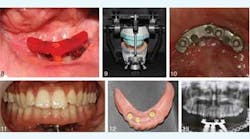Your jaw bones affect how you look, breath, eat, and speak, making reconstruction important for any jaw defects. Surgeons have more tools than ever to tackle such cases, but these may not be enough to ensure the jaw is fully restored. In the end, it’s all about form and function.
The authors of an article published in the current issue of the Journal of Oral Implantology described a step-by-step process to completely reconstruct the jaw using a bone graft and an implant-supported denture. Their case report is one of only a few studies that focus on the final, prosthetic phase of the process and a technique known as a free-flap fibula graft.ADDITIONAL READING |Bone regeneration through tissue engineering offers new prospects for oral procedures Free-flap reconstruction is the standard technique used after part or all of a patient’s jaw has been removed. Surgeons prefer to use bone from the patient’s fibula to rebuild the jaw. Such reconstruction is ideal, providing adequate bone length, blood supply, and consistent shape in the jaw, as well as minimal risk of disease in the leg. Still, successfully rebuilding the jaw may not be enough to restore a patient’s normal appearance and abilities. Dentures may not stay in place, so dental implants are often used for added support. The current case report focuses on a 24-year-old woman. A tumor in her jaw had been removed three years earlier and a fibular graft had been used to rebuild her jawbone, but the graft was not successful. A second surgery was performed using the free fibular vascular flap of her other leg, and four implants and a denture were inserted.ADDITIONAL READING |A comparison of graft techniques for the alveolar ridge prior to oral implant Over the next two years, the patient reported great comfort and ability to function with the prosthesis. She could wear the denture easily and eat a mostly normal diet, except for nuts and meats. Her speech was clear, and her facial proportions and symmetry were closer to normal. For this patient, the plastic attachments had to be replaced once due to routine wear and tear. She had no problems in the leg that had been used as the donor site. The patient felt good about her rehabilitation, which made her confident in her appearance and daily activities. The authors concluded that their method is safe and reliable. They said that it resulted in a functional and esthetically acceptable jaw that greatly enhanced the patient’s quality of life. Full text of the article “Total Mandibular Reconstruction and Rehabilitation: A Case Report,” Journal of Oral Implantology, Vol. 41, No. 6, 2015, is available here. The Journal of Oral Implantology is the official publication of the American Academy of Implant Dentistry. It is dedicated to providing valuable information to general dentists, oral surgeons, prosthodontists, periodontists, scientists, clinicians, laboratory owners and technicians, manufacturers, and educators. The Journal of Oral Implantology distinguishes itself as the first and oldest journal in the world devoted exclusively to implant dentistry. For more information, visit their website.





